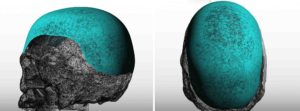Skull implants today can be designed to cover any surface area of the skull that needs to be augmented. Utilizing the patient’s 3D CT scan, its design and size is only limited by the limitations imposed by the elasticity of the scalp. (how much can the scalp stretch to accommodate what lies underneath it)
Typically skull implants that cover larger surface areas of the skull have more projection (thickness) as well in an effort to make he overall skull larger. In most of these cases a first stage scalp expander is needed to be able to accommodate the large skull implant secondarily.


Such total coverage skull implants are for patients that have an unevenness or a skull surface irregularities, some modest frontal or occipital asymmetries or a top of the head that has a peak or depression and lacks a more pleasing convex contour. They are one of the least requested custom skull implant design due to their large surface area coverage but in the properly selected patient can be very effective.
Dr. Barry Eppley
Indianapols Indiana


